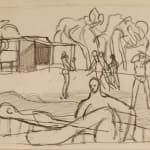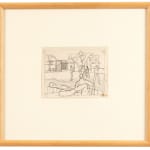Keith Vaughan
La Baignade, Avignon, 1951
signed with initials (lower right)
pencil
10.3 x 13.4 cm
4 x 5 1/4 in
4 x 5 1/4 in
Currency:
KEITH VAUGHAN No 770 LA BAIGNADE, AVIGNON, 1951 From; 'The Journal', September 1951 Avignon - September 1951 'The backbone is the long boulevard tree-lined and lit by bright shops and...
KEITH VAUGHAN
No 770 LA BAIGNADE, AVIGNON, 1951
From; 'The Journal', September 1951
Avignon - September 1951 'The backbone is the long boulevard tree-lined and lit by bright shops and hotels, which leads from the station, outside the walls, up to the Place, mounting slowly all the way. The Place is the highest point and at the top of the Place is the Palais des Papes, highest of all. On either side the streets lead away, infected for a short distance with chromium glitter of the boulevard, then gradually returning to the crumbling sun-baked stone. Finally everything piles up in shambles of dust, stone and litter against the turreted medieval walls which surround the city on all sides, holding it together. Beyond the walls is the Rhone, turbulent and green. Rats approach within twenty yards of the boulevard after midnight.'
La Baignade 'Opposite the city the Rhone divides and forms a large island in the middle. Nearer the city, the Grand Rhone is fierce and turbulent, but beyond the island the Petie Rhone is calm and gentle. Here is laid out the Bagnade Municipal. A short stretch of the river bank has been dressed with pebbles and sand and stretching out into the water, marking the boundaries of the Baignade, are duckboards attached to empty oil drums. There is a ramshackle wooden structure where, for the price of 40frs, you can hire a changing room, but which in fact nobody but a few rather particular Frenchmen ever use. Here is also a buvette with two long trestle tables beneath a sagging awning of bamboo poles where there is always a group of honey-coloured youths who never enter the water, but stand about in unbelievably picturesque attitudes against a background of small dusty olive and fig trees, as though part of a fresco by Piero della Francesca. At the other end of the pebbly beach, as far away as possible from this Olympian scene, is a stretch of dried-mud dunes on which the Moorish boys roll each other until they attain the colour of volcanic ash.'
From 'Keith Vaughan his Life and Work', Malcolm Yorke, 1990
'In 1950 he went to Italy, calling in at Pisa, Sienna and Naples and again returning through France. A year later he was back cycling around Avignon, the Rhone Valley and the Camargue. From each of these tours he returned with new landscape memories and tiny notebook sketches which fed into his work. His ambition now was to be a European painter rather than a merely English one.'
No 770 LA BAIGNADE, AVIGNON, 1951
From; 'The Journal', September 1951
Avignon - September 1951 'The backbone is the long boulevard tree-lined and lit by bright shops and hotels, which leads from the station, outside the walls, up to the Place, mounting slowly all the way. The Place is the highest point and at the top of the Place is the Palais des Papes, highest of all. On either side the streets lead away, infected for a short distance with chromium glitter of the boulevard, then gradually returning to the crumbling sun-baked stone. Finally everything piles up in shambles of dust, stone and litter against the turreted medieval walls which surround the city on all sides, holding it together. Beyond the walls is the Rhone, turbulent and green. Rats approach within twenty yards of the boulevard after midnight.'
La Baignade 'Opposite the city the Rhone divides and forms a large island in the middle. Nearer the city, the Grand Rhone is fierce and turbulent, but beyond the island the Petie Rhone is calm and gentle. Here is laid out the Bagnade Municipal. A short stretch of the river bank has been dressed with pebbles and sand and stretching out into the water, marking the boundaries of the Baignade, are duckboards attached to empty oil drums. There is a ramshackle wooden structure where, for the price of 40frs, you can hire a changing room, but which in fact nobody but a few rather particular Frenchmen ever use. Here is also a buvette with two long trestle tables beneath a sagging awning of bamboo poles where there is always a group of honey-coloured youths who never enter the water, but stand about in unbelievably picturesque attitudes against a background of small dusty olive and fig trees, as though part of a fresco by Piero della Francesca. At the other end of the pebbly beach, as far away as possible from this Olympian scene, is a stretch of dried-mud dunes on which the Moorish boys roll each other until they attain the colour of volcanic ash.'
From 'Keith Vaughan his Life and Work', Malcolm Yorke, 1990
'In 1950 he went to Italy, calling in at Pisa, Sienna and Naples and again returning through France. A year later he was back cycling around Avignon, the Rhone Valley and the Camargue. From each of these tours he returned with new landscape memories and tiny notebook sketches which fed into his work. His ambition now was to be a European painter rather than a merely English one.'
Provenance
Austin Desmond Fine Art, Ascot, 14th March 1987Professor Rodney Fitch C.B.E.
Woolley & Wallis, Salisbury, 8th June 2016, where purchased by
John Constable
Literature
Ross, Alan, Keith Vaughan - Journals and Drawings, 1966, (ill. p.123)Publications
Cat. 9 in Keith Vaughan : The Male MuseCourtesy of Zuleika Gallery
Copyright The Artist



